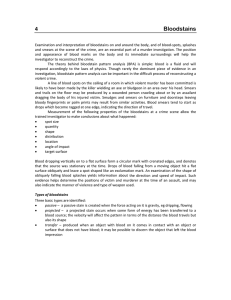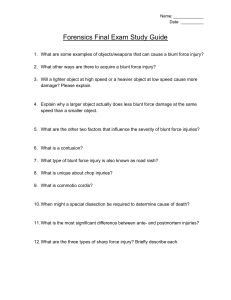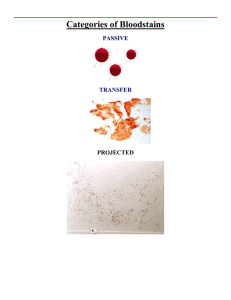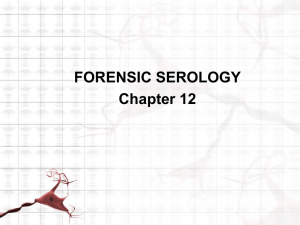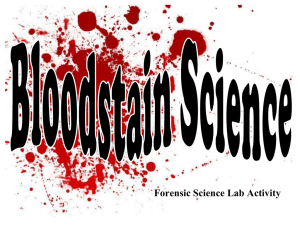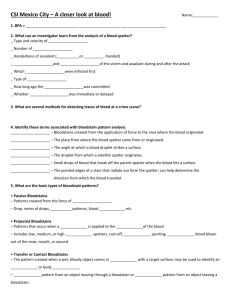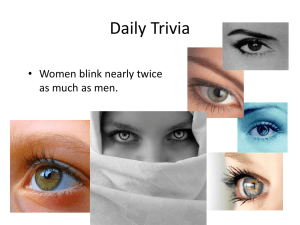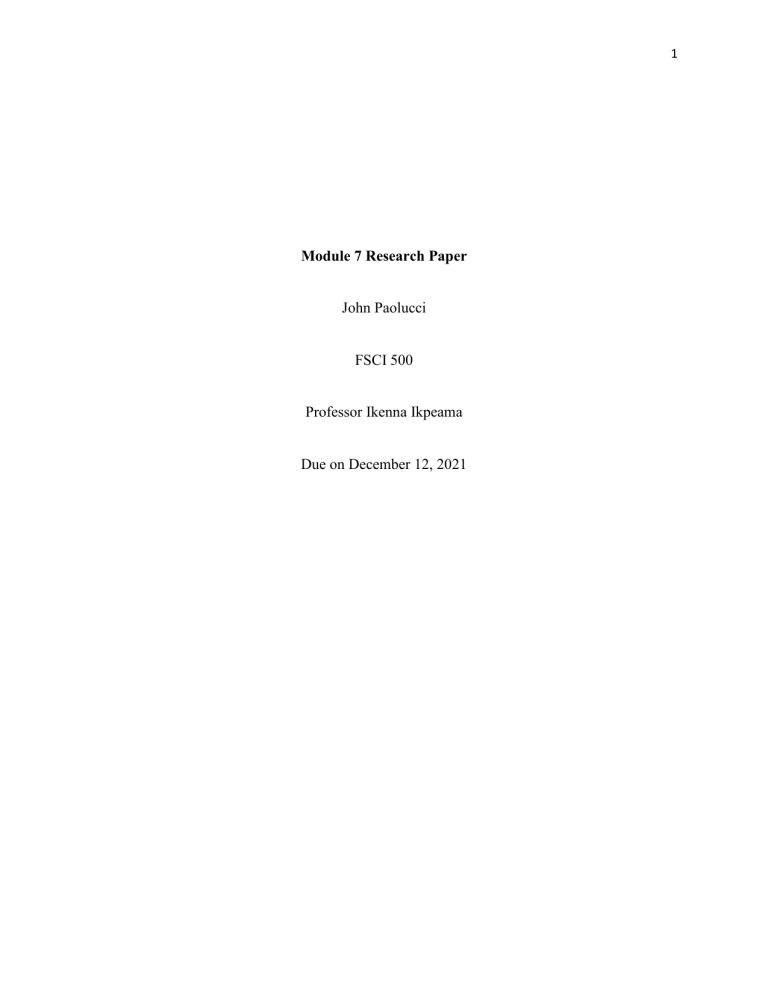
1 Module 7 Research Paper John Paolucci FSCI 500 Professor Ikenna Ikpeama Due on December 12, 2021 2 Introduction The American Academy of Forensic Sciences’ Standards Board (ASB) issued a report in 2017 that delineates and defines the terminology for Bloodstain Pattern Analysis. The ASB “Technical Report 33 – Terms and Definitions in Bloodstain Pattern Analysis” defines a “backspatter pattern” as: “A bloodstain pattern resulting from blood drops which can be produced when a projectile creates an entrance wound.” In shooting incident reconstruction, gunshot wounds that produce a backspatter pattern can provide vital information such as a victim’s location within the crime scene when the gunshot wound was inflicted, a shooter’s proximity to a gunshot entrance wound, and, in some cases, the identity of the shooter. Unfortunately, not all gunshot entrance wounds produce backspatter patterns that can be found at a crime scene because variables such as the caliber of the bullet, the limited distance that backspatter can travel, characteristics of the substrate onto which it was deposited, the location on the body where the gunshot wound was inflicted, and clothing worn by the victim, can mitigate any potential for backspatter production. The presence of a backspatter pattern at a crime scene, on a firearm, or even the clothing or hands of the shooter has immense investigative value. It can often be the deciding factor in determining a manner of death in suicide cases or link a shooter to a crime scene by depositions of small bloodstains on a shooter's person, clothing, or weapon found in his/her possession. One caveat is that the failure to properly identify backspatter can be problematic and even lead to wrongful convictions. 3 Backspatter Production Mechanisms The backspatter phenomenon has been attributed to several mechanisms that have to do with mechanical factors such as the caliber and velocity of the bullet that created the entrance wound, usually combined with physiological factors such as wound location. The most commonly cited explanation for the generation of backspatter is the “temporary cavity” phenomenon. “This temporary stretching of the surrounding tissues then collapses back to the permanent wound cavity. This collapse of the temporary wound cavity often occurs after both the entrance and exit of the projectile, leaving two holes from which blood may be ejected by the force of the collapse.” (Bevel et al., 2008) “Studies by Dr. Martin Fackler suggest that the collapse of the temporary wound cavity produced by the projectile is responsible for spatter production.” (James et al., 2005) “As the elastic response involves the acceleration of tissue retrograde to the bullet path, it potentially could provide a mechanism for the expulsion of backspatter.” (Davidson et al., 2012). Simply put, the energy from the bullet is transferred to the tissue and causes an expansion of the tissue as the bullet passes through. Some of the damage is permanent and some aspects (stretching of tissue) are temporary. As the temporarily stretched tissue in the wound track contracts, blood that accumulated in that wound track, also referred to as the permanent cavity, can be forced out of the entrance wound. 4 Figure 1 shows an image of a bullet captured by a high-speed camera, as it traverses a bloodsoaked sponge that was covered with tape. The right side of the sponge shows the formation of backspatter as very small blood drops are projected back towards the direction of force. Figure 1: Forward Spatter and Backspatter from a bullet impact. Source: Midwest Forensic Resource Center Davidson et al. provide an in-depth examination of the physiological aspects relating to the generation of backspatter and delineate five (5) mechanisms that result from the interaction of a bullet with human tissue in their article “Physical Components of Soft-Tissue Ballistic Wounding and Their Involvement in the Generation of Blood Backspatter” (Davidson et al., 2012). The five components are: 1. Elastic Component 2. Viscous Component 3. Crushing Component 4. Cutting Component 5. Thermal Component. 5 The elastic component has to do with the above-mentioned temporary cavity effect. The elastic components of human tissue such as elastin and collagen will react to the kinetic energy of the bullet and stretch upon impact and as the bullet travels, storing energy as “strain energy” which is then returned when the tissue relaxes. This action could cause blood and tissue fragments to be propelled back towards the entrance wound (Davidson et. al., 2013). The authors further explain that this scenario would be more apparent in high elasticity tissue with muscle and skin as examples, compared to brain tissue. The viscous component explores soft tissue as being more fluid-like than the solid it is considered to be. Tissue is composed of mostly water and free-floating molecules and the bullet creates a vacuum, similar to shooting into water. The bullet creates a void that is filled with liquid (blood) directly behind the bullet. Then, due to the vacuum, the void collapses which forces the liquid blood out of the hole from which the bullet entered, the entrance wound (Davidson et. al., 2013). The crushing component is responsible for creating the permanent cavity mentioned above. Fracture, destruction, and displacement of tissue forms the permanent cavity and the tissue destruction can be responsible for creating loose biological matter to be propelled back to the entrance hole through this permanent cavity access (Davidson et. al., 2013). Accompanying the crushing component is the cutting component where the force of the bullet exceeds the tissue’s bond strength and cuts into the tissue. Dr. Vincent DiMaio describes skin as differing from other tissue in that the initial force required to perforate skin is relatively high, and for a .38 caliber bullet to perforate skin, a minimum velocity of 191 ft./sec. is necessary (DiMaio, 1999). Once the bullet perforates the skin, pressure radiates outwardly from the bullet path in an oscillating wave that can squeeze liquid into the temporary cavity and propel it out of the entrance hole (Davidson et. al., 2013). 6 Finally, Davidson et al. describe the thermal component as a chemical reaction caused by the heat of the bullet, creating gasses that expand, to form within the wound cavity, providing an “explosion gas” that propels blood and other materials through the wound cavity. The authors explain that the discipline of Thermodynamics explains such a process but concede that further research is needed into the role of the thermal component in gunshot wounds. Factors That Impede the Discovery of Backspatter at a Crime Scene Dr. Vincent DiMaio provides data on backspatter production based on his experience as a forensic pathologist and stresses the importance of wound location as a metric on which to base the likelihood that backspatter will be produced by a gunshot wound. He provides a best-case and a worstcase scenario claiming that a gunshot wound to the head from a large caliber weapon is more likely to produce backspatter than a small caliber firearm discharged from long range and wounding the victim in the torso (DiMaio, 1999). Dr. DiMaio also cites a study where incidences of backspatter found on the shooting hands of suicide victims were studied and the firearm type and likelihood of discovering backspatter were compared. In this study, 103 cases of suicide by contact gunshot wounds were compared; 18 of the firearms were revolvers, 52 were semi-automatic pistols, 22 were a rifle or shotgun, and in 11 of the 103 cases, the weapon was unknown. Overall, only 32% of the cases produced backspatter on the shooting hands that was detectable by the naked eye (DiMaio, 1999). Figure 2 is presented in Mr. Ed Hueske’s book on shooting incident analysis and reconstruction and offers an example of how backspatter will appear when found on the shooter’s hand (Hueske, 2016). 7 Figure 2: Backspatter on Shooter's Hand Source: Hueske, 2016 Backspatter was found on the shooting hand in 33% of the cases involving revolvers, 35% of the cases involving semi-automatic pistols, and 27% of the cases involving rifles and shotguns. All of the cases involving handguns were gunshots to the head, and when the rifle/shotgun incidents are condensed to only include gunshots to the head, the percentage increases to 37.5%. The study also found that larger caliber handguns had higher incidences of backspatter, with 9mm pistols producing backspatter on the shooting hand in 50% of the cases (DiMaio, 1999). With almost 2/3 of gunshot suicides producing no detectable backspatter on the shooter’s hands, one has to invoke the adage, “Absence of evidence is not evidence of absence” when using backspatter to determine if a gunshot was self-inflicted or in fact a homicide. Another limitation to backspatter is the relatively short distance that it will travel. Blood drops in flight are subject to the forces of air resistance and gravity which they must continually fight against to remain in flight. Because bloodstains created as the result of a gunshot wound, such as backspatter, are so small, they lack the mass necessary to overcome these forces. It has been reported that blood drops from backspatter will be limited to approximately 4 ft. of travel due to their size (James et al, 2005). 8 Haag et al. mention experiments, such as the one performed in Figure 1, where they are designed to create ideal conditions for the production of abundant backspatter (Haag et al., 2011). To their point, if you imagine that a sweatshirt and a down ski jacket were covering the sponge when the shot was fired, it is easy to see that what we’re able to create through experiments may have limitations when applied to real-life crime scene scenarios. Even a loosely fitting T-shirt could stop backspatter from being deposited on items beyond the shirt. Mr. Hueske also teaches us that factors such as a victim's clothing, hats and hair can reduce or eliminate spatter, both forward spatter and backspatter, at crime scenes involving gunshot events (Hueske, 2016). Even when backspatter is produced in abundance, it may not necessarily be discovered by crime scene investigators for several reasons. One reason may be the substrate onto which it was deposited. Because the majority of blood drops that result from backspatter are very small (< 1mm), the color of the substrate may mask their appearance. In one case investigated by this author, there was a question as to whether or not a knife, alleged to have been used to threaten the defendant, had been planted by the defendant after he shot the victim. The blade of the knife was red in color and the fine bloodstains that can be attributed to a gunshot event couldn’t easily be seen. To make bloodstains more apparent, we must create contrast. This can be done chemically or by using various light sources to allow the blood to stand out. Oblique lighting can be useful when attempting to find small bloodstains on dark-colored, non-porous surfaces and alternate light sources are very useful for creating contrast. Although blood does not fluoresce in the same way other bodily fluids do under UV lighting, blood will darken when UV light is applied. If the substrate reacts differently or not at all to the UV light, the bloodstain will become apparent. Figure 3 shows the knife from the above case, under visible light (top) and then with UV light applied and the image converted to grayscale 9 in Photoshop. The very small spatter stains typical to a gunshot event can be seen very clearly when contrast is created through lighting. Figure 3: Top: Knife with gunshot spatter on red blade photographed with white light. Bottom: The same knife was photographed with 455 nm UV light and grayscale conversion. Source: Paolucci CSI Experts Inc Investigative value of Backspatter With the above limitations in mind, the crime scene investigator should make attempts to find backspatter at shooting incident crime scenes as well as on shooters' hands, clothing, and the firearm suspected of firing the bullet that caused the injury. 10 With firearms, detecting a victim’s blood on the outside of the firearm or inside the barrel can be highly probative evidence. Dr. DiMaio also studied bloodstains on firearms in instances of contact wounds, where the muzzle is in contact with the victim. This study involved 653 revolvers, 242 semiautomatic pistols, 181 shotguns, and 124 rifles that were used in suicides. Blood was detected on the firearms' muzzle through visual and chemical examinations in 79% of the cases. 74% of the revolvers had blood on the muzzle, 76% of the pistols, 85% of the shotguns, and 58% of the rifles also had blood on the muzzle. Blood was detected on the inside of the barrel in 53% of the revolvers, 57% of the semiautomatic pistols, 72% of the shotguns, and 58% of the rifles (DiMaio, 1999). Backspatter can sometimes be detected on the hands and/or clothing of the shooter. If there is any doubt as to who fired the shot that caused a gunshot wound, backspatter on the hands of a suspect is extremely damning evidence. Again, consider that backspatter was only found in about 1/3 of the cases in the study cited by Dr. DiMaio and all the factors that can hinder production and deposition of backspatter before impeaching a defendant's version of events based on a lack of backspatter. With that in mind, understand the significance of finding backspatter on the suspect or his/her clothing! When search warrants are executed on a suspect’s residence, clothing that may have bloodstains deposited on it is one of the things investigators are seeking. Obviously, light colored clothing can show bloodstains as small as those found in backspatter patterns, but dark colored clothing can easily mask such bloodstains, so much that the shooter may have examined his own clothing and determined that there are no bloodstains on them. In these situations, infrared photography can be very useful for detecting bloodstains that are hidden by the dye of the fabric. Figure 4 shows side-by-side images of a garment onto which bloodstains were deposited. The image on the left shows the garment photographed in the visible light spectrum and the image on the right is the same garment photographed with a full spectrum camera using a 695 nm infrared filter. The 11 filter allows a narrow range of near infrared wavelengths to pass through. The blood on the shirt absorbs the infrared wavelengths while the shirt’s dye reflects them, allowing for the capture of the bloodstains and not the dye that is masking them when the garment is viewed in the visible light spectrum with the naked eye. Figure 4: Photo of garment with bloodstains - Left: Visible Light Right: Infrared with Photoshop enhancement = change to grayscale Source: Paolucci CSI Experts Inc. Bloodstains That Have a Similar Appearance to Backspatter Edward E. Hueske lists three (3) dynamics that can create small spatter stains as would typically be produced by a gunshot event in the form of forward spatter or backspatter (Hueske, 2016): 1. Blood dripping into blood 2. Expirated blood 12 3. Fly Specks Blood dripping into blood causes the formation of satellite spatter, which are smaller stains breaking free from the much larger “parent stain” following impact. Figure 5 shows a screenshot from a video where large blood drops fell onto cardboard and as a result of their impact, particularly where blood drops landed on top of other liquid blood, the larger bloodstains are surrounded by the smaller, satellite bloodstains. It may appear obvious that this is what happened because you can see the larger bloodstains in proximity to the smaller bloodstains, but when these patterns are found in the much busier context of a crime scene, perhaps with a blood pool that obscures the larger bloodstains, the appearance of these satellite bloodstains can be deceiving and mistaken for forward or backspatter. 13 Figure 5: Blood dripping into blood with satellite spatter resembling gunshot-produced spatter. Source: Midwest Forensic Resource Center Expirated blood results from blood finding its way into the victim’s airways, and from there it is expelled in the form of very small droplets. There are ways to differentiate expirated blood from backspatter and forward spatter such as laboratory analyses to test for amylase which is found in saliva, and sometimes there are air bubbles or “vacuoles” that can be observed in the bloodstains. Also, some of the bloodstains may be connected to each other by strands or “ligaments” as the blood is bound together by saliva. Figure 6 shows the small droplets created by expirated blood with ligaments forming by the mouth of the subject who is exhaling the blood. It is important to check autopsy reports for blood in the victim’s airways when looking at patterns that have characteristics of forward spatter or backspatter. The final dynamic, fly specks, occurs when flies that are in an area of the crime scene where there is blood, then move to another location where the blood is regurgitated, leaving small, circular Figure 6: Expirated blood showing small bloodstains with characteristics of backspatter and ligaments by the mouth. Source: Midwest Forensic Research Center 14 bloodstains that can be mistaken for impact spatter such as backspatter. Hueske explains that blood from a body can be consumed by flies, then regurgitated on another area of the body. Because of circumstances such as this, Hueske cautions crime scene investigators who are processing a “shooting” scene to first establish that a shot or shots were actually fired, as ridiculous as that may sound (Hueske, 2016). Perils Associated With Misidentifying Backspatter: Indiana v. David Camm David Camm was a former Indiana State Trooper who claimed that he came home one evening and found his wife and two children shot to death in the garage of the home where they lived. Mr. Camm claimed that he discovered their bodies while returning home from playing basketball, and believed that his son, who was in the back seat of their Ford Bronco with his sister, was still alive and he would be able to perform CPR on him. This meant he had to reach over the body of his deceased daughter to remove his son from the passenger side of the two-door SUV (Deforrest et al., 2021). An examination of Mr. Camm's clothing revealed small bloodstains near the bottom of his Tshirt that the state claimed were deposited due to a backspatter event that he caused when he shot his family members. Mr. Camm's defense was that the bloodstains must have been deposited as the result of a contact transfer between his shirt and blood that was on his daughter's hair. A DNA profile was developed from the blood of those small stains and it was determined to be the blood of Mr. Camm's daughter (Deforrest et al., 2021). The bloodstains were small, as you would expect from a backspatter pattern or something as fine as a human hair, but only numbered between three and eight depending on who was testifying. In Figure 1, we can see that bloodstains from backspatter are numerous, but we also know that things such as hair can inhibit backspatter production. Another thing we know is that backspatter has been found to be absent a good percentage of the time as per Dr. DiMaio’s studies. Dr. DiMaio also showed us that 15 gunshot wounds to the head produce backspatter more frequently than gunshot wounds to other areas of the body – and the theories and relevant studies are volleyed between opposing experts. Mr. Camm was convicted at trials twice and was lucky enough to get a third trial. The minimal number of bloodstains, their appearance being consistent with a contact transfer, and finally, a 3D reconstruction of events that showed how shooting the daughter from outside of the Bronco would have prevented the area of the T-shirt on which the bloodstains were found, from being exposed to any backspatter produced by the gunshot wound to the daughter's head (Fig. 7), all came together for the third jury who acquitted Mr. Camm after deliberating for 10 hours (Deforrest et al., 2021). Figure 7: 3D reconstruction of David Camm incident. Bloodstains were on the lower left area of the T-shirt and not exposed to airborne blood drops such as backspatter. Source: DeForrest et al. 2021 Conclusion Properly Applying Principles of Backspatter to a Criminal Investigation and Prosecution With an understanding of the limitations and the investigative value associated with backspatter, investigators need to be certain when basing opinions and conclusions on the presence or absence of backspatter, that their analysis was properly performed, and any variables and uncertainties 16 were considered and are clearly stated in reports and testimony. The David Camm case should make this abundantly clear. The power of forensic evidence to the finder of fact cannot be underestimated and sometimes a little knowledge is a dangerous thing as the saying goes. As we’ve seen, an absence of backspatter is not conclusive, but neither is the discovery of small bloodstains on the clothing of a person believed to be involved in a shooting incident. Backspatter can be very strong, highly probative evidence when the analyst knows what it is, how to find it and the limitations associated with its production as well as dynamics that can mimic it. DNA analysis of backspatter patterns on suspect’s clothing, especially the sleeve area, can be the “smoking gun” when all the necessary caveats are properly addressed, with objectivity and fairness. 17 References Bevel, T., & Gardner, R. M. (2008). Bloodstain Pattern Analysis : with an Introduction to Crime Scene Reconstruction. Boca Raton: Crc Press/Taylor & Francis. . Davidson, P., Taylor, M., Wilson, S., Walsh, K.,Kieser, J., (2012) Physical Components of SoftTissue Ballistic Wounding and Their Involvement in the Generation of Blood Backspatter. Journal of Forensic Sciences vol. 57, No. 5 doi: 10.1111/j.15564029.2012.02143.x DeForrest, P., Pizzola, P., & Kammrath, B., (2021). Blood Traces: Interpretation of Deposition and Distribution. Hoboken, Nj Wiley. Dimaio, V. (1998). Gunshot Wounds: Practical Aspects of Firearms, Ballistics, and Forensic Techniques, SECOND EDITION. CRC Press. Haag, M. G., Haag, L. C., & Academic Press (Londyn. (2011). Shooting Incident Reconstruction. San Diego ; Oxford: Academic Press Is An Imprint Of Elsevier, Cop. Hueske, E. E. (2016). Practical Analysis and Reconstruction of Shooting Incidents. Boca Raton, FL CRC Press: James, S. H., Kish, P. E., &amp; Sutton, T. P. (2005). Principles of Bloodstain Analysis: Theory and Practice. Boca Raton, FL: CRC.
